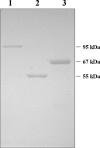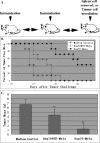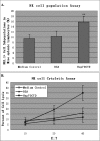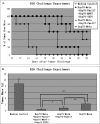Fusion proteins of Hsp70 with tumor-associated antigen acting as a potent tumor vaccine and the C-terminal peptide-binding domain of Hsp70 being essential in inducing antigen-independent anti-tumor response in vivo
- PMID: 17009594
- PMCID: PMC1576472
- DOI: 10.1379/csc-191r.1
Fusion proteins of Hsp70 with tumor-associated antigen acting as a potent tumor vaccine and the C-terminal peptide-binding domain of Hsp70 being essential in inducing antigen-independent anti-tumor response in vivo
Abstract
Hsp70s are a family of ATP-dependent chaperones of relative molecular mass around 70 kDa. Immunization of mice with Hsp70 isolated from tumor tissues has been proved to elicit specific protective immunity against the original tumor challenge. In this work, we investigated whether Hsp70 can be used as vehicle to elicit immune response to its covalence-accompanying antigen. A recombinant protein expression vector was constructed that permitted the production of recombinant protein fusing tumor-associated antigen (eg, Mela) to the C terminus of Hsp70. We found that the Hsp70-Mela fusion protein can elicit strong cellular immune responses against murine tumor B16, which expresses protein Mela. The Hsp70 peptide-binding domain deletion mutant of the fusion protein was sufficient for inducing Mela-specific cytotoxic T lymphocyte but was not sufficient for engendering potent anti-tumor immunity against B16. We also found that host natural killer (NK) cells were stimulated in vivo by C-terminal domain of Hsp70. We thus presume that Hsp70 fusion proteins suppress tumor growth via at least 2 distinct pathways: one is covalence-accompanying antigen dependent; another is antigen independent. The C-terminal domain of Hsp70 seemed to be the crucial part in eliciting antigen-independent responses, including NK cell stimulation, against tumor challenges. Furthermore, we found that immunization with multiple Hsp70 fusion proteins resulted in a better anti-tumor effect.
Figures







Similar articles
-
Heat shock protein 70/MAGE-3 fusion protein vaccine can enhance cellular and humoral immune responses to MAGE-3 in vivo.Cancer Immunol Immunother. 2005 Sep;54(9):907-14. doi: 10.1007/s00262-004-0660-3. Epub 2005 Mar 9. Cancer Immunol Immunother. 2005. PMID: 15756604 Free PMC article.
-
Fusion protein of ATPase domain of Hsc70 with TRP2 acting as a tumor vaccine against B16 melanoma.Immunol Lett. 2006 Jun 15;105(2):167-73. doi: 10.1016/j.imlet.2006.02.004. Epub 2006 Mar 10. Immunol Lett. 2006. PMID: 16580737
-
A novel DNA vaccine constructed by heat shock protein 70 and melanoma antigen-encoding gene 3 against tumorigenesis.Indian J Exp Biol. 2010 May;48(5):436-43. Indian J Exp Biol. 2010. PMID: 20795360
-
Could mycobacterial Hsp70-containing fusion protein lead the way to an affordable therapeutic cancer vaccine?Expert Rev Vaccines. 2015 Mar;14(3):435-46. doi: 10.1586/14760584.2015.979797. Epub 2014 Dec 13. Expert Rev Vaccines. 2015. PMID: 25496347 Review.
-
Message in a bottle: role of the 70-kDa heat shock protein family in anti-tumor immunity.Eur J Immunol. 2005 Sep;35(9):2518-27. doi: 10.1002/eji.200535002. Eur J Immunol. 2005. PMID: 16144035 Review.
Cited by
-
A central role for inducible heat-shock protein 70 in autoimmune vitiligo.Exp Dermatol. 2013 Sep;22(9):566-9. doi: 10.1111/exd.12183. Epub 2013 Jun 20. Exp Dermatol. 2013. PMID: 23786523 Free PMC article. Review.
-
Recombinant complexes of antigen with stress proteins are potent CD8 T-cell-stimulating immunogens.J Mol Med (Berl). 2008 Sep;86(9):1067-79. doi: 10.1007/s00109-008-0371-x. Epub 2008 Jun 13. J Mol Med (Berl). 2008. PMID: 18551265
-
N-terminally fusion of Her2/neu to HSP70 decreases efficiency of Her2/neu DNA vaccine.Cell Stress Chaperones. 2010 Sep;15(5):631-8. doi: 10.1007/s12192-010-0175-0. Epub 2010 Mar 12. Cell Stress Chaperones. 2010. PMID: 20224916 Free PMC article.
-
Role of Heat Shock Proteins in Immune Modulation in Malaria.Adv Exp Med Biol. 2021;1340:169-186. doi: 10.1007/978-3-030-78397-6_7. Adv Exp Med Biol. 2021. PMID: 34569025
-
Diversity of extracellular HSP70 in cancer: advancing from a molecular biomarker to a novel therapeutic target.Front Oncol. 2024 Apr 5;14:1388999. doi: 10.3389/fonc.2024.1388999. eCollection 2024. Front Oncol. 2024. PMID: 38646439 Free PMC article. Review.
References
-
- Belli F, Testori A, and Rivoltini L. et al. 2002 Vaccination of metastatic melanoma patients with autologous tumor-derived heat shock protein gp96-peptide complexes: clinical and immunologic findings. J Clin Oncol. 20:4169–4180. - PubMed
-
- Blachere NE, Li ZH, Chandawarkar RY, Suto R, Jaikaria NS, Basu S, Udono H, Srivastava PK. Heat shock protein–peptide complexes, reconstituted in vitro, elicit peptide-specific cytotoxic T lymphocyte response and tumor immunity. J Exp Med. 1997;186:1315–1322.0022-1007(1997)186[1315:HSPCRI]2.0.CO;2 - PMC - PubMed
Publication types
MeSH terms
Substances
LinkOut - more resources
Full Text Sources
